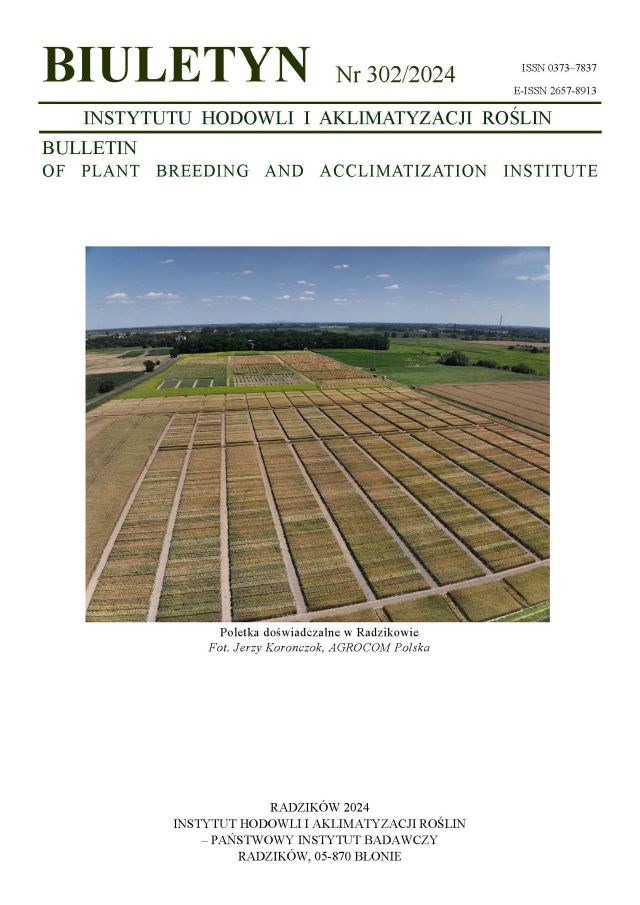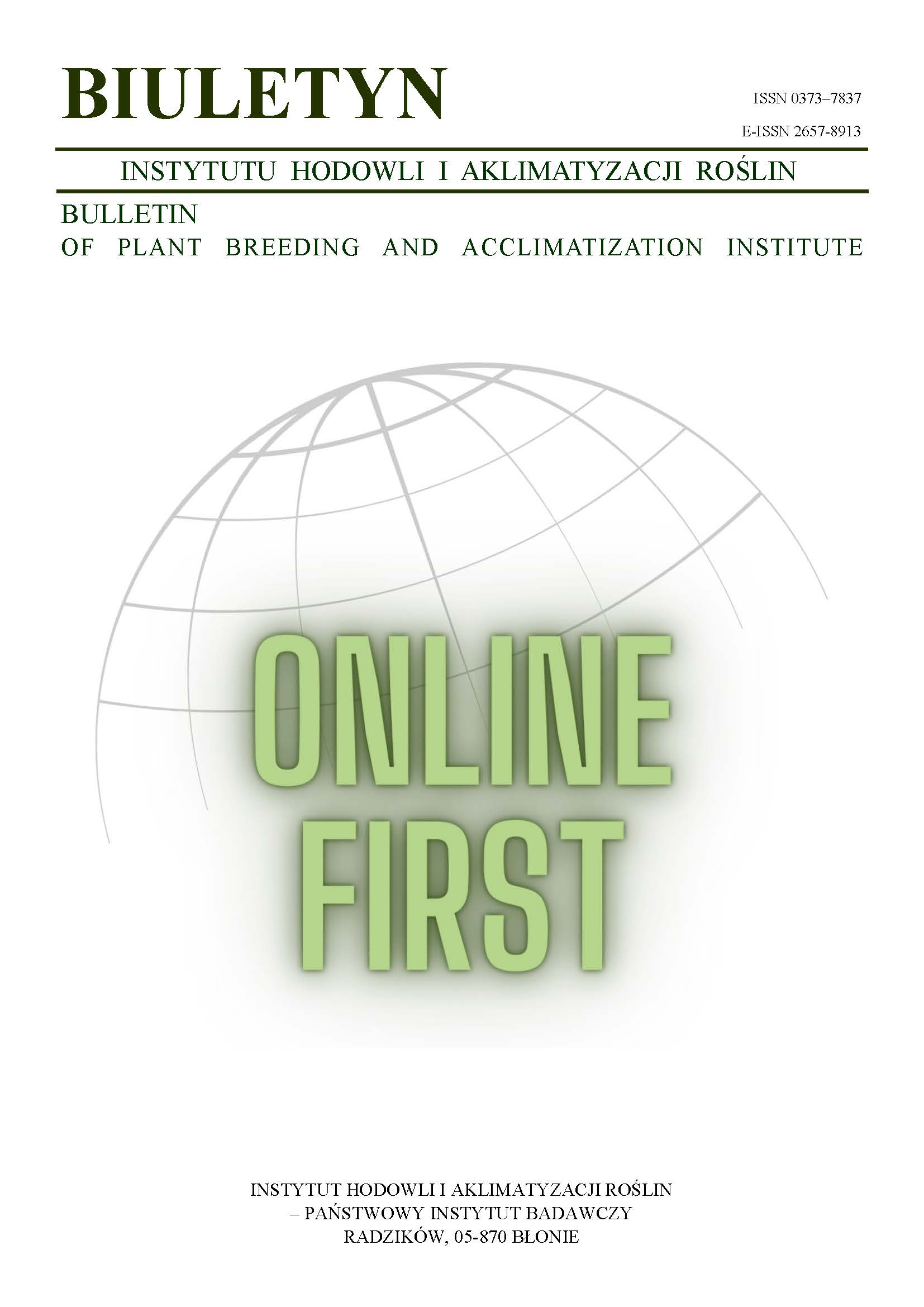Yielding of new dwarf and semi-dwarf naked oat varieties
Robert Maciorowski
wksir@zut.edu.plZakład Doświadczalnictwa, Katedra Uprawy Roli, Roślin i Doświadczalnictwa, Akademia Rolnicza w Szczecinie (Poland)
Zygmunt Nita
Hodowla Roślin „Strzelce” Sp. z o.o. (Poland)
Krystyna Werwińska
Hodowla Roślin „Strzelce” Sp. z o.o. (Poland)
Sławomir Stankowski
Zakład Doświadczalnictwa, Katedra Uprawy Roli, Roślin i Doświadczalnictwa, Akademia Rolnicza w Szczecinie (Poland)
Abstract
The field plot experiments were conducted in the years 2003–2004. In the first year 23 varieties were tested of dwarf and semi-dwarf naked oats (with dwarfing genes introduced form the Badicoot variety) together with the traditional — tall naked varieties Akt and Polar and hulled variety Chwat. In the next year 18 naked oat dwarf and semi-dwarf varieties and one dwarf hulled oat variety — STH 5630 were compared with the traditional tall oat varieties Polar and Chwat. The introduction of dwarfing genes caused the reduction of plant height from 31 to 50%, compared with the tall varieties Akt and Polar. The height reduction was not dependent on field and weather conditions. The following varieties were distinguished: STH 7091 (naked) — characterized by high panicle density, long panicle with low number of grains per panicle with high weight of 1000 grains; STH 7146 (naked) — with relatively lower panicle density but high grain yield per panicle, caused by higher number of grains per panicle; STH 5630 — characterized by high panicle density and high number of grains per panicle. Any effects of dwarfing genes on growth stages timing, plant development and number of hulled grains were not observed.
Keywords:
dwarfing genes, naked oat, varieties, yield, yield componentsReferences
Anderson W. K., McLean R. 1989. Increased responsiveness of short oat cultivars to early sowing, nitrogen fertilizer and seed rate. Aust. J. Agric. Res. 40: 729 — 744.
DOI: https://doi.org/10.1071/AR9890729
Google Scholar
Anonim. 1999. Oats in new era. Semundo Ltd, Cambridge.
Google Scholar
Austin R. B. 1999. Yield of wheat in the United Kingdom: recent advances and prospects. Crop Sci. 39: 1604 — 1610.
DOI: https://doi.org/10.2135/cropsci1999.3961604x
Google Scholar
Austin R. B., Ford M. A., Morgan C. L. 1989. Genetic improvement in yield of winter wheat: A further evaluation. J. Agric. Sci. Cam. 112: 295 — 301.
DOI: https://doi.org/10.1017/S0021859600085749
Google Scholar
Barr A. R. 1988. Breeding oats for Mediterranean-type environments. In: Proceedings of 3rd International Oat Conference, Lund, Sweden, Eds. Mattsson B., Lyhagen R. Svalöv AB, Sweden: 24 — 34.
Google Scholar
Barr A. R., Pelham S. D., Zwer P. K. 1996. Hulless oat — building a commercial future. Proceedings of the V International Oat Conference & VII International Barley Genetics. University of Saskatchewan, Saskatoon, USA. Eds. Slinkard A., Scoles G., Rossnagel B., University Extension Press, University of Saskatchewan, Saskatoon, Saskatchewan: 97 — 105.
Google Scholar
Berry P. M., Spink J. H., Foulkes M. J., Wade A. 2003. Quantifying the contributions and losses of dry matter from non-surviving shoots in four cultivars of winter wheat. Field Crops Res. 80: 111 — 121.
DOI: https://doi.org/10.1016/S0378-4290(02)00174-0
Google Scholar
Brown P. D., McKenzie R. I. H., Mikaelsen K. 1980. Agronomic, genetic and cytologic evaluation of vigorous new semi dwarf oat. Crop Sci. 20: 303 — 306.
DOI: https://doi.org/10.2135/cropsci1980.0011183X002000030003x
Google Scholar
Calderini D. F., Slafer G. A. 1998. Changes in yield and yield stability in wheat during the 20th century. Field Crops Res. 57: 335 — 347.
DOI: https://doi.org/10.1016/S0378-4290(98)00080-X
Google Scholar
Cyfert R. 2002, 2003, 2004, 2005. Owies. Lista opisowa odmian. COBORU, Słupia Wielka.
Google Scholar
Cyfert R., Michalak A., Najewski A., Zych J. 2005. Wyniki porejestrowych doświadczeń odmianowych. Zboża jare. 2004 (pszenica, jęczmień, owies, pszenżyto). COBORU, Słupia Wielka. Numer 32.
Google Scholar
Farnham M. W., Stuthman D. D., Biesboer D. D. 1990. Cellular expression of panicle exertion in semidwarf oat. Crop Sci. 30: 323 — 328.
DOI: https://doi.org/10.2135/cropsci1990.0011183X003000020016x
Google Scholar
Federizzi L. C., Qualset C. O. 1989. Genetic of plant height reduction and panicle type in oat. Crop Sci. 29: 551 — 557.
DOI: https://doi.org/10.2135/cropsci1989.0011183X002900030001x
Google Scholar
Kibite S., Clayton G. 2000. Effects of the Dw6 dwarfing gene on agronomic and grain quality features of oats. In: Proceedings International Oat Conference. Lincoln, NZ. Ed. Cross R. J. New Zealand Inst. for Crop and Food Res. Lmtd., Christchurch, NZ: 312 — 316.
Google Scholar
Mäkela P., Muurinen S., Peltonen-Sainio P. 2004. Alterations in growth and canopy architecture among dwarf, semidwarf and tall oat lines grown under northern conditions. Agric. Food Sci. 13 (1–2): 170 — 185.
DOI: https://doi.org/10.2137/1239099041838030
Google Scholar
Mäkela P., Väärälä L., Peltonen-Sainio P. 1996. Agronomic comparison of Minnesota-adapted dwarf oat with semi-dwarf, intermediate, and tall oat lines adapted to northern growing conditions. Can. J. Plant Sci.76: 727 — 734.
DOI: https://doi.org/10.4141/cjps96-125
Google Scholar
McKey J. 1988. Shoot:root interrealtions in oats. In: Proceedings of 3rd International Oat Conference, Lund, Sweden, Eds. Mattsson B., Lyhagen R. Svalöv AB, Sweden: 340 — 344.
Google Scholar
Milach S. C. K., Rines H. W., Phillips R. L., Stuthman D. D., Morikawa T. 1998. Inheritance of new dwarfing gene in oat. Crop Sci. 38: 356 — 360.
DOI: https://doi.org/10.2135/cropsci1998.0011183X003800020013x
Google Scholar
Milach S. C. K., Rines H. W., Phillips R. L. 1997. Molecular genetic mapping of dwarfing genes in oat. Theor. Appl. Genet. 95: 783 — 790.
DOI: https://doi.org/10.1007/s001220050626
Google Scholar
Milach S. C. K., Rines H. W., Phillips R. L. 2002. Plant height components and gibberellic acid response of oat dwarf lines. Crop Sci. 42: 1147 — 1154.
DOI: https://doi.org/10.2135/cropsci2002.1147
Google Scholar
Milach S. C. K., Federizzi L. C. 2001. Dwarfing genes in plant improvement. Adv. Agron. 73: 35 — 65.
DOI: https://doi.org/10.1016/S0065-2113(01)73004-0
Google Scholar
Miralles D. J., Katz S. D., Colloca A., Slafer G. A. 1998. Floret development in near isogenic wheat lines differing in plant height. Field Crops Res. 59: 21 — 30.
DOI: https://doi.org/10.1016/S0378-4290(98)00103-8
Google Scholar
Morikawa T. 1988. New genes for dwarfism transferred from wild oats Avena fatua into cultivated oat. In: Procceedings of 3rd International Oat Conference, Lund, Sweden, Eds. Mattsson B., Lyhagen R. Svalöv AB, Sweden: 41 — 46.
Google Scholar
Morikawa T., Kuriyama S. 2004. Genetic diversity among dwarf inbred lines of oats revealed by microsatellites. In: Proceedings 7th International Oat Conference. Helsinki, Finland. Eds. Peltonen-Sainio P., Topi-Hulmi M. MTT, Agrifood Res. Finland: 172.
Google Scholar
Nita Z. 1999. Stan aktualny i nowe kierunki hodowli owsa w Polsce. Żywność Supl. 1(18): 186 — 192.
Google Scholar
Nita Z. 2003. Współczesne osiągnięcia i perspektywy hodowli owsa w Polsce. Biul. IHAR 229: 13 — 20.
Google Scholar
Petonen-Sainio P. 1994. Yield component differences between naked and conventional oat. Agron. J. 86: 510 — 513.
DOI: https://doi.org/10.2134/agronj1994.00021962008600030010x
Google Scholar
Peltonen-Sainio P. 1997. Groat yield and plant stand structure of naked and hulled oat under different nitrogen fertilizer and seeding rates. Agron. J. 89: 140 — 147.
DOI: https://doi.org/10.2134/agronj1997.00021962008900010021x
Google Scholar
Peltonen-Sainio P., Rajala A. 2001. Chloromequat chloride and ethephon affect growth and yield formation of conventional, naked and dwarf oat. Agric. Food Sci. Finl. 10: 165 — 174.
DOI: https://doi.org/10.23986/afsci.5691
Google Scholar
Peltonen-Sainio P., Rajala A., Simmons S., Caspers R., Stuthman D. 2003. Plant growth regulator and day length effects on pre-anthesis main shoot and tiller growth in conventional and dwarf oat. Crop Sci. 43: 227 — 233.
DOI: https://doi.org/10.2135/cropsci2003.2270
Google Scholar
Piech M., Nita Z., Maciorowski R. 2001. Reakcja owsa nieoplewionego i oplewionego na nawożenie azotem. Biul. IHAR 217: 111 — 119.
Google Scholar
Rajala A., Peltonen-Sainio P. 2001. Plant growth regulator effects on spring cereal root and shoot growth. Agron. J. 93: 936 — 943.
DOI: https://doi.org/10.2134/agronj2001.934936x
Google Scholar
Shearman V. J., Sylvester-Bradley R., Scott R. K., Foulkes M. J. 2005. Physiological processes associated with wheat yield progress in the UK. Crop Sci. 45: 175 — 185.
DOI: https://doi.org/10.2135/cropsci2005.0175a
Google Scholar
Slafer G. A. 2003. Genetic basis of yield as viewed from a crop physiologist's perspective. Ann. App. Biol. 142: 117 — 128.
DOI: https://doi.org/10.1111/j.1744-7348.2003.tb00237.x
Google Scholar
Valentine J. 1995. Naked oats. In: The oat crop. Ed. Welch R. W. Chapman & Hall, London: 504 — 532.
DOI: https://doi.org/10.1007/978-94-011-0015-1_16
Google Scholar
Valentine J., Hale O. D. 1990. Investigation into reduced germination of seed of naked oats. Plant Varieties and Seeds 3: 21 — 30.
Google Scholar
Zych J. 2001. Owies. Lista opisowa odmian. COBORU, Słupia Wielka.
Google Scholar
Authors
Robert Maciorowskiwksir@zut.edu.pl
Zakład Doświadczalnictwa, Katedra Uprawy Roli, Roślin i Doświadczalnictwa, Akademia Rolnicza w Szczecinie Poland
Authors
Zygmunt NitaHodowla Roślin „Strzelce” Sp. z o.o. Poland
Authors
Krystyna WerwińskaHodowla Roślin „Strzelce” Sp. z o.o. Poland
Authors
Sławomir StankowskiZakład Doświadczalnictwa, Katedra Uprawy Roli, Roślin i Doświadczalnictwa, Akademia Rolnicza w Szczecinie Poland
Statistics
Abstract views: 29PDF downloads: 18
License
Copyright (c) 2006 Robert Maciorowski, Zygmunt Nita, Krystyna Werwińska, Sławomir Stankowski

This work is licensed under a Creative Commons Attribution-ShareAlike 4.0 International License.
Upon submitting the article, the Authors grant the Publisher a non-exclusive and free license to use the article for an indefinite period of time throughout the world in the following fields of use:
- Production and reproduction of copies of the article using a specific technique, including printing and digital technology.
- Placing on the market, lending or renting the original or copies of the article.
- Public performance, exhibition, display, reproduction, broadcasting and re-broadcasting, as well as making the article publicly available in such a way that everyone can access it at a place and time of their choice.
- Including the article in a collective work.
- Uploading an article in electronic form to electronic platforms or otherwise introducing an article in electronic form to the Internet or other network.
- Dissemination of the article in electronic form on the Internet or other network, in collective work as well as independently.
- Making the article available in an electronic version in such a way that everyone can access it at a place and time of their choice, in particular via the Internet.
Authors by sending a request for publication:
- They consent to the publication of the article in the journal,
- They agree to give the publication a DOI (Digital Object Identifier),
- They undertake to comply with the publishing house's code of ethics in accordance with the guidelines of the Committee on Publication Ethics (COPE), (http://ihar.edu.pl/biblioteka_i_wydawnictwa.php),
- They consent to the articles being made available in electronic form under the CC BY-SA 4.0 license, in open access,
- They agree to send article metadata to commercial and non-commercial journal indexing databases.
Most read articles by the same author(s)
- Piotr Stefański, Patrycja Siedlarz, Przemysław Matysik, Zygmunt Nita, Krystyna Rybka, The usefulness of light sources based on diodes characterized by a continuous spectrum of white light enriched with a blue band in cereal breeding , Bulletin of Plant Breeding and Acclimatization Institute: No. 284 (2018): Regular issue
- Przemysław Matysik, Zygmunt Nita, Ewelina Matysik, Effectiveness of selection criteria applied in F4 progeny of winter wheat on the basis of yield components , Bulletin of Plant Breeding and Acclimatization Institute: No. 244 (2007): Regular issue
- Patrycja Siedlarz, Piotr Stefański, Przemysław Matysik, Zygmunt Nita, Krystyna Rybka, The effect of different LED illuminators on the germination index of wheat grains obtained in the greenhouse stage of the SSD breeding process , Bulletin of Plant Breeding and Acclimatization Institute: No. 282 (2017): Regular issue
- Tadeusz Śmiałowski, Maria Bogacka, Zygmunt Nita, Edward Witkowski, The use of multifactorial analysis of variance in estimation of winter hardiness of winter wheat strains , Bulletin of Plant Breeding and Acclimatization Institute: No. 259 (2011): Regular issue
- Krystyna Rybka, Zygmunt Nita, Modern phenotypes of cereals for growing in areas endangered with drought , Bulletin of Plant Breeding and Acclimatization Institute: No. 273 (2014): Regular issue
- Bogusław Łapiński, Zygmunt Nita, Aleksandra Szołkowska, Patrycja Wieczorek, A hybrid of cultivated oat with the wild species Avena macrostachya as a source of new variation for yield quality improvement in naked oats , Bulletin of Plant Breeding and Acclimatization Institute: No. 270 (2013): Regular issue
- Zygmunt Nita, Memories - Mgr Tadeusz Rydzewski (1925-2022) , Bulletin of Plant Breeding and Acclimatization Institute: No. 297/298 (2022): Regular issue
- Grażyna Podolska, Leszek Maj, Zygmunt Nita, Effect of sowing density and nitrogen fertilization doses on grain yield and yield components of naked short-shoot oat , Bulletin of Plant Breeding and Acclimatization Institute: No. 239 (2006): Regular issue
- Wioletta Biel, Krum Petkov, Robert Maciorowski, Zygmunt Nita, Izabela Jaskowska, Estimation of oat grain quality on the basis of chemical composition , Bulletin of Plant Breeding and Acclimatization Institute: No. 239 (2006): Regular issue
- Tadeusz Śmiałowski, Zygmunt Nita, Edward Witkowski, Estimation of the interrelationships between different traits of winter wheat using the path analysis , Bulletin of Plant Breeding and Acclimatization Institute: No. 240/241 (2006): Regular issue














